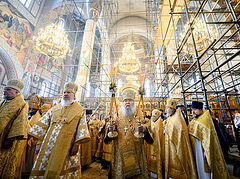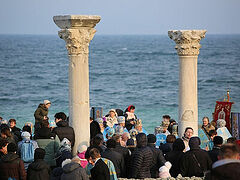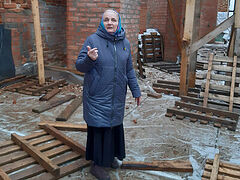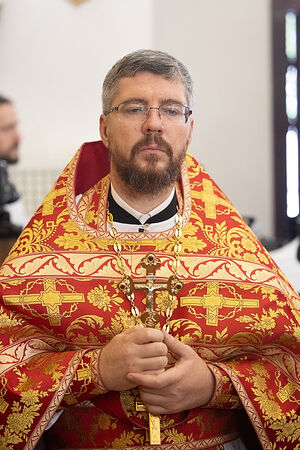 Priest Dionisy Kamenshchikov When a new cross appeared in the spring sky over the ancient village of Strigay in the Bazarny-Karabulak district of the Saratov region, it became clear that the common cause of the restoration of the dilapidated and desolate St. Nicholas Church had passed the point of no return. The village church, which served as a granary for many years and then was turned into terrible ruins overgrown with trees and bushes, is being transformed day by day. St. Nicholas Church is again becoming itself—a church.
Priest Dionisy Kamenshchikov When a new cross appeared in the spring sky over the ancient village of Strigay in the Bazarny-Karabulak district of the Saratov region, it became clear that the common cause of the restoration of the dilapidated and desolate St. Nicholas Church had passed the point of no return. The village church, which served as a granary for many years and then was turned into terrible ruins overgrown with trees and bushes, is being transformed day by day. St. Nicholas Church is again becoming itself—a church.
But what Herculean efforts it took just to uproot the “thickets”, take out all household garbage and broken bricks from the church, cover it first with a temporary, and then a permanent roof, fit windows and doors, make the floor, order and then raise a cupola with a cross!... Now an extra building is being constructed: it will house a boiler room, a Sunday school, and perhaps a small hostel for those who will wish to make a pilgrimage to Strigay. A park has been laid around the church. The installation of the heating system of the church and its interior decoration are planned for the near future.
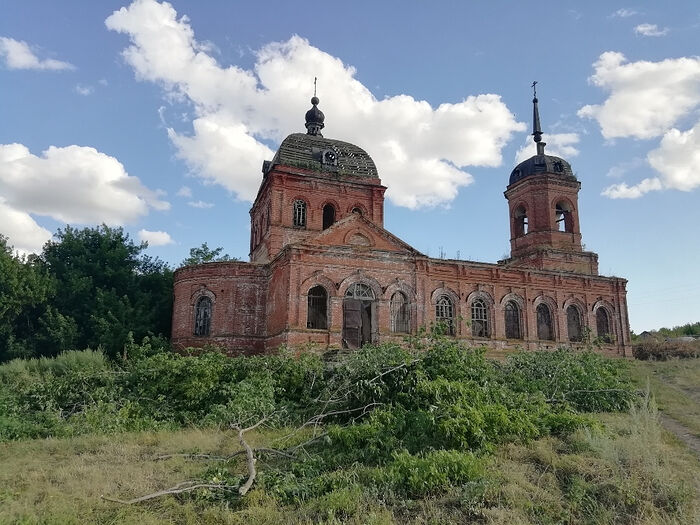 St. Nicholas Church in Strigay before the restoration
St. Nicholas Church in Strigay before the restoration
And all this is without powerful and high-ranking patrons and benefactors, only with ordinary people’s money on the principle: “Many a little makes a mickle”. A small group of enthusiasts and volunteers rallied around Priest Dionisy Kamenshchikov, rector of St. Elias Church in the city of Saratov. Few believed in success when Fr. Dionisy was starting this project other than those nearest him, his family.
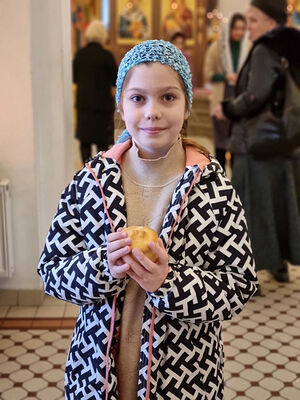 Little Xenia Kamenshchikova, with whose question it all began Actually, it all began with the question of little Xenia Kamenshchikova:
Little Xenia Kamenshchikova, with whose question it all began Actually, it all began with the question of little Xenia Kamenshchikova:
“Father, you’ll restore it, won’t you?”
Xenia found herself within the walls of the ruined church with her parents and elder sister Barbara almost by chance. In the unforgettable spring of 2020, the Kamenshchikovs, tired of endless waves of COVID, constant worries and anxiety, decided to take a break and go off to the countryside. The road unexpectedly led them to Strigay, and it is impossible not to notice the old church there. Even in its dilapidated state it strikes you with its wistful grandeur and ascetic beauty.
Of course, the young daughter’s question was just a stimulus and occasion for the priest: he himself immediately realized that he would not allow this church to disappear. And he took on full responsibility for its future restoration, which then seemed hopeless and even perhaps “inappropriate”—when the whole country was straining itself in the fight against COVID. But pandemics come and go, and churches must stand until the end of time.
Denis Alexandrovich Kamenshchikov entered the Saratov Theological Seminary at the age of twenty-eight. He already had a higher education, and had worked in science and business. His path to the Church and then the priesthood was thorny yet very determined—one day he realized exactly what he needed and has never strayed from the path since. He overcame inevitable spiritual crises by fighting fire with fire. Once, for example, he went to a remote steppe monastery to perform obedience as a laborer. In fact, the monastery did not yet exist—the neglected territory of a former neuropsychiatric home was put at the disposal of a single monk, and everything had to be started from scratch. Hard work under the scorching sun of the steppe did what others get from great spiritual fathers and clairvoyant elders—the seminarian returned to Saratov a different person. After reading Denis Kamenshchikov’s essay about this experience, I came to believe in him as a priest. But let’s return to Strigay.
Fr. Dionisy had another motive to take up the restoration of this rural church. As the rector of the newly built St. Elias Church in Saratov, he was looking for a common cause—not something one–time, but long-term and creative, so that it would help unite his parishioners and create a living community. And, indeed, his parishioners were the first to respond to his call. Regular clean–up days began, with parishioners clearing the church interior. People immediately felt that they needed it, and their lives were changing there.
And it was important for Fr. Dionisy to ensure that people come to believe in themselves:
“With God’s help we can fully restore all our desecrated holy churches ourselves, with our ordinary means, without waiting when government representatives or ‘owners of factories, newspapers and steamships’1 want to do it. I am glad that the bulk of our funds are small donations from people who learned about us from social media or in their churches. We must make sure that together we can do a great deal.”
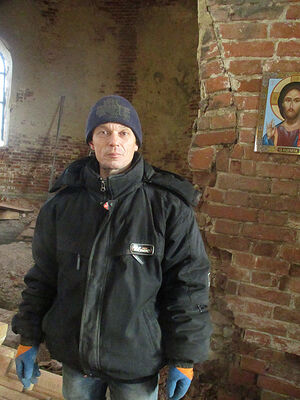 The team-leader of the builders in Strigay Vitaly Khrustalev But if anyone can take out garbage, repair and construction work requires qualifications. Here Fr. Dionisy heeded the advice of his guides (particularly the engineer Alexei Odinokov, a parishioner of St. Elias Church). A small team of local Strigay men is working at the construction site; they receive salaries, also from donations. The team-leader Vitaly Khrustalev, a father of a large family and a former city dweller, is convicted that the most important thing in life is to leave something behind you to your children, grandchildren and country. Fr. Dionisy says the same thing: Every church, whether restored or newly built, is our eternal message to future generations. Unhappy is the man who cannot go beyond his earthly life and is able to do only what will die with him. An illustration of this is a fragile oak sapling beside the walls of St. Nicholas Church in Strigay:
The team-leader of the builders in Strigay Vitaly Khrustalev But if anyone can take out garbage, repair and construction work requires qualifications. Here Fr. Dionisy heeded the advice of his guides (particularly the engineer Alexei Odinokov, a parishioner of St. Elias Church). A small team of local Strigay men is working at the construction site; they receive salaries, also from donations. The team-leader Vitaly Khrustalev, a father of a large family and a former city dweller, is convicted that the most important thing in life is to leave something behind you to your children, grandchildren and country. Fr. Dionisy says the same thing: Every church, whether restored or newly built, is our eternal message to future generations. Unhappy is the man who cannot go beyond his earthly life and is able to do only what will die with him. An illustration of this is a fragile oak sapling beside the walls of St. Nicholas Church in Strigay:
“When we were taking out the garbage that had piled up over several decades from the church—cans, bottles and even wine glasses—one of our parishioners found an acorn. This is despite the fact that there are no oaks in the area (according to the Great Saratov Encyclopedia, the oak forest around Strigay were cut down back in the 1880s). She brought the acorn home and managed to germinate it. Then she brought the sprout to Strigay, and we planted it. I tinkered with it the whole summer, watering and weeding it. Oaks grow very slowly, and we may not live to see when this one becomes a mighty tree. But everyone who will come to Strigay, to our St. Nicholas Church, will know the story of this oak tree. They will definitely know. We will try our best to ensure it.”
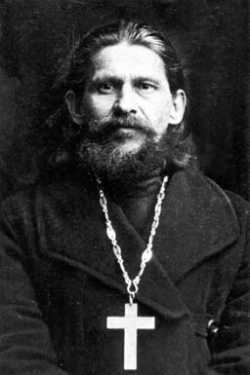 The New Priest-Martyr Peter Zinoviev The holy New Priest-Martyr Peter Zinoviev served at St. Nicholas Church in Strigay. He was its last rector before the church was closed. Born in the village of Bereznyaki in the Voskresenka district of the Saratov province, a father of four, he was charged with “showing dissatisfaction with the Soviet Government, spreading rumors of an imminent war with the Nazis, counterrevolutionary activities against the Soviet Constitution,” and the like. He was executed by a firing squad on December 29, 1937 in the town of Bezhetsk of the Tver region. At first Fr. Dionisy and everyone involved in the restoration of the church in Strigay knew nothing about Hieromartyr Peter. But once they heard about him, they got added evidence that there are no “coincidences” in this life. Now, on Fr. Dionisy’s initiative and with the help of the Secretary of the Diocesan Commission for the Canonization of the saints, Priest Maxim Plyakin, a service has been composed (and is already used in church) to the holy Hieromartyr Peter. And it was on his feast-day, December 29, that the ruling hierarch, Metropolitan Ignatius (Deputatov) of Saratov and Volsk, came to Strigay for the first time. He blessed the cupola and the cross, which had yet to crown “Nikola in Strigay” (as St. Nicholas’ Church in Strigay is affectionately called).
The New Priest-Martyr Peter Zinoviev The holy New Priest-Martyr Peter Zinoviev served at St. Nicholas Church in Strigay. He was its last rector before the church was closed. Born in the village of Bereznyaki in the Voskresenka district of the Saratov province, a father of four, he was charged with “showing dissatisfaction with the Soviet Government, spreading rumors of an imminent war with the Nazis, counterrevolutionary activities against the Soviet Constitution,” and the like. He was executed by a firing squad on December 29, 1937 in the town of Bezhetsk of the Tver region. At first Fr. Dionisy and everyone involved in the restoration of the church in Strigay knew nothing about Hieromartyr Peter. But once they heard about him, they got added evidence that there are no “coincidences” in this life. Now, on Fr. Dionisy’s initiative and with the help of the Secretary of the Diocesan Commission for the Canonization of the saints, Priest Maxim Plyakin, a service has been composed (and is already used in church) to the holy Hieromartyr Peter. And it was on his feast-day, December 29, that the ruling hierarch, Metropolitan Ignatius (Deputatov) of Saratov and Volsk, came to Strigay for the first time. He blessed the cupola and the cross, which had yet to crown “Nikola in Strigay” (as St. Nicholas’ Church in Strigay is affectionately called).
On May 22 2023, the spring feast of St. Nicholas the Wonderworker, Vladyka Ignatius came to Strigay for the second time and, with a large concourse of locals, celebrated the first Divine Liturgy in eighty-six years within the walls of the church. Many people remembered Vladyka’s sermon:
“Today, the feast of the Translation of the Relics of St. Nicholas to Bari, we have performed the Bloodless Sacrifice here. It has already been proven by centuries of experience and it has become an axiom that when the Divine Liturgy begins to be celebrated in a church, it and everything around it begins to invisibly revive. When a person tries to make efforts, and at the same time the Bloodless Sacrifice is performed, everything blossoms in the literal and figurative senses, and first of all souls are resurrected. I believe that through the prayers of St. Nicholas, through the prayers of our dear Fr. Valery, through the labors and prayers of Fr. Dionisy who takes care of this church, we are witnessing a Paschal miracle today… The Lord sends us people who help us—sometimes penny by penny. It is a real miracle when caring people revive a church by their joint efforts.”
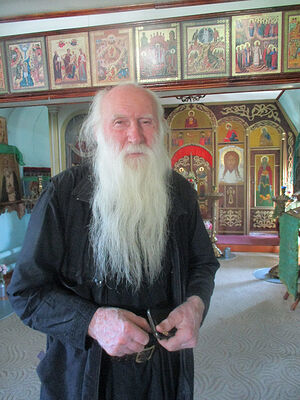 Archpriest Valery Koroteyev It’s time to tell readers about Fr. Valery Koroteyev mentioned by Vladyka. There is another, active church in Strigay, dedicated to the Protecting Veil of the Mother of God, located in an adapted house. Money for its purchase was collected by the whole village. The seventy-nine-year–old Fr. Valery, who was baptized at age forty-four and became a priest at fifty-three, is the rector of this church. His wife Margarita Fyodorovna helps the priest in everything. For many years she taught French at the Saratov Seminary. Throughout his ministry in Strigay, Fr. Valery was looking at the dying St. Nicholas Church with an aching heart and couldn’t do anything. He organized cross processions from the Protection Church to the ruined St. Nicholas church twice a year on the winter and the spring feasts of St. Nicholas, and in the summer the parishioners pulled out the grass, trying to clear the inner space somehow… But they didn’t have the strength; the rural parish was rapidly aging and dwindling. But when Fr. Dionisy appeared in Strigay with young and energetic helpers, when it became clear to everyone that they were undertaking this work seriously, the community of the Protection Church collected almost 80,000 rubles (at the time it would have been about $1,400) for them.
Archpriest Valery Koroteyev It’s time to tell readers about Fr. Valery Koroteyev mentioned by Vladyka. There is another, active church in Strigay, dedicated to the Protecting Veil of the Mother of God, located in an adapted house. Money for its purchase was collected by the whole village. The seventy-nine-year–old Fr. Valery, who was baptized at age forty-four and became a priest at fifty-three, is the rector of this church. His wife Margarita Fyodorovna helps the priest in everything. For many years she taught French at the Saratov Seminary. Throughout his ministry in Strigay, Fr. Valery was looking at the dying St. Nicholas Church with an aching heart and couldn’t do anything. He organized cross processions from the Protection Church to the ruined St. Nicholas church twice a year on the winter and the spring feasts of St. Nicholas, and in the summer the parishioners pulled out the grass, trying to clear the inner space somehow… But they didn’t have the strength; the rural parish was rapidly aging and dwindling. But when Fr. Dionisy appeared in Strigay with young and energetic helpers, when it became clear to everyone that they were undertaking this work seriously, the community of the Protection Church collected almost 80,000 rubles (at the time it would have been about $1,400) for them.
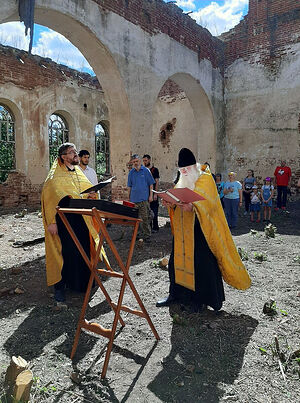 Prayer service within the walls of the ruined church. Fr. Dionisy and Fr. Valery And now the gray-haired Fr. Valery is always next to Fr. Dionisy, who is young enough to be his son. They always celebrate prayer services together within the walls of the church under restoration. It seems that it is very easy for Fr. Valery to climb a vertical ladder to the church roof—he wants to see everything with his own eyes!
Prayer service within the walls of the ruined church. Fr. Dionisy and Fr. Valery And now the gray-haired Fr. Valery is always next to Fr. Dionisy, who is young enough to be his son. They always celebrate prayer services together within the walls of the church under restoration. It seems that it is very easy for Fr. Valery to climb a vertical ladder to the church roof—he wants to see everything with his own eyes!
The village of Strigay was founded in the early eighteenth century and was mainly settled by soldier-plowmen. The construction of the first Church of St. Nicholas commenced at their request in 1765. In 1795, this church burned down along with most of the village. Then it was rebuilt. According to information from 1910, there were 623 peasant farmsteads and 3,741 residents in the village. At the same time, the construction of a school and a new church (the one we are talking about in this article) were completed in the village. Information about the fate of the earlier church in Strigay is very contradictory.
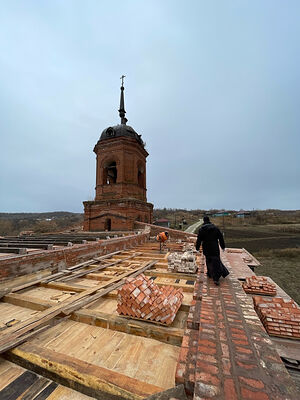 Neither snow nor rain will fall in the church anymore Currently, Strigay officially has around 800 residents. The village is alive, but its prospects are not at all bright. Alas, this is the reality of thousands of Russian villages, but each of them is a part of Russia and its history…
Neither snow nor rain will fall in the church anymore Currently, Strigay officially has around 800 residents. The village is alive, but its prospects are not at all bright. Alas, this is the reality of thousands of Russian villages, but each of them is a part of Russia and its history…
Of course, Fr. Dionisy is very often asked: “How do you see the future of the restored church? Who are you restoring it for? Who will come to worship in it in ten or twenty years?” Fr. Dionisy has his own vision: The church can become a destination for Sunday pilgrimages. How joyful it will be for a family of city dwellers to come here on Sunday, pray at the Divine Liturgy, and then spend a day in the countryside! In addition, a counter-process to the depopulation of villages has already begun. Farming is gaining momentum, and there is a tendency for city dwellers to migrate to villages.
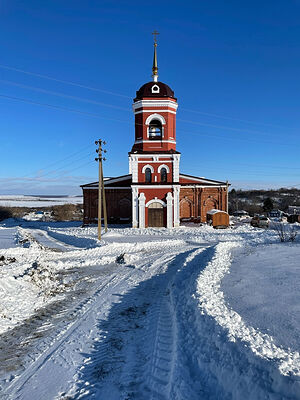 St. Nicholas Church in Strigay today It’s all true. We should also say of the experience in our metropolia, that over the past fifteen or twenty years, quite a few churches have been restored in rural areas in villages that seemingly had no future… And none of them are empty now. Besides, let us recall the words of Vladyka Ignatius: “When the Divine Liturgy begins to be celebrated in a church, it and everything around it begins to revive invisibly… and first of all souls are resurrected.” Yes, that is true, and such examples abound. When a doleful ruin (where obscene graffit can be found on the inner walls, mixed with the remnants of beautiful paintings) becomes a church again, when this church finally opens its doors to worshippers, people’s attitudes towards life, their native village and towards themselves change. A half–forgotten feeling comes to life again in their hearts: love for their native village. Then they have the desire to live here, at home.
St. Nicholas Church in Strigay today It’s all true. We should also say of the experience in our metropolia, that over the past fifteen or twenty years, quite a few churches have been restored in rural areas in villages that seemingly had no future… And none of them are empty now. Besides, let us recall the words of Vladyka Ignatius: “When the Divine Liturgy begins to be celebrated in a church, it and everything around it begins to revive invisibly… and first of all souls are resurrected.” Yes, that is true, and such examples abound. When a doleful ruin (where obscene graffit can be found on the inner walls, mixed with the remnants of beautiful paintings) becomes a church again, when this church finally opens its doors to worshippers, people’s attitudes towards life, their native village and towards themselves change. A half–forgotten feeling comes to life again in their hearts: love for their native village. Then they have the desire to live here, at home.
Undoubtedly, restoring a church does not mean solving all the problems of today’s villages. But is it possible to solve them without a cross over the village?

